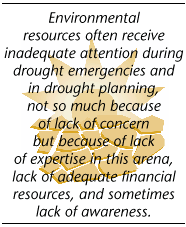|
|
| Return to Table of Contents |
stemmed from local and state governmental activity or from private and nongovernmental entities. As an example, the California Urban Water Conservation Council identified 14 best management practices, three of which relate to education, public awareness, and communications. One calls for organizations to identify a "water conservation coordinator" as a single contact point for information. Two others call for development and implementation of coordinated public and school education programs. Included in the education programs are workshops, newsletters, public service announcements, press releases, town hall meetings, school curricula, bill stuffers for utilities, and interactive participatory decision-making processes. These techniques and others provide communication links among organizations that provide assistance and the people whom they serve. Such techniques also help increase awareness of the value of preparedness to reduce costly impacts of droughts. There is little federal assistance available for such programs, but there are a few examples of federal public education efforts related to drought. One is the National Weather Service’s recent addition of drought concerns to its annual spring media briefings on the water supply outlook. For the March 13, 2000, presentation, the Weather Service prepared a public document to emphasize the importance of preparing for drought. In addition, the Weather Service produced maps to show current drought areas nationwide as well as seasonal drought outlooks and provided a list of drought information sources. On another front, the National Disaster Education Coalition, a group of public and private organizations that provides educational materials and information on natural hazards, met in February 2000 to discuss a plan for incorporating drought into its ongoing efforts. We were cautioned, however, that there is a need to include the media in public education outreach. Widespread but misinformed drought alerts can do damage to state or regional tourism and recreation economies when the actual impacts may be confined to a small portion of the state or region. Need to Address As many people testified
during our hearings or through written comments, drought can have
devastating impacts on aquatic and terrestrial environmental resources,
as well as on human users of water. Aquatic ecosystems are exceptionally
vulnerable to the effects of drought conditions, manifested as
reductions in streamflows, and populations of terrestrial wildlife are
placed under stress when severe drought conditions develop. Habitat
quality and quantity gradually decline from lack of moisture, increasing
the competition for limited resources. Wildlife species eventually
suffer from lack of drinking water, forage, and cover and from heat
stress. We heard that the biotic impacts of drought are particularly
acute for threatened, endangered, and sensitive species of fish and
wildlife that are characteristically found in low population densities.
In many cases, such species have already encountered damage to or
destruction of their natural environments because of factors such as
suburban sprawl, conversion of land to agricultural or industrial uses,
and construction of large dams or other impoundments.
|
|
|

